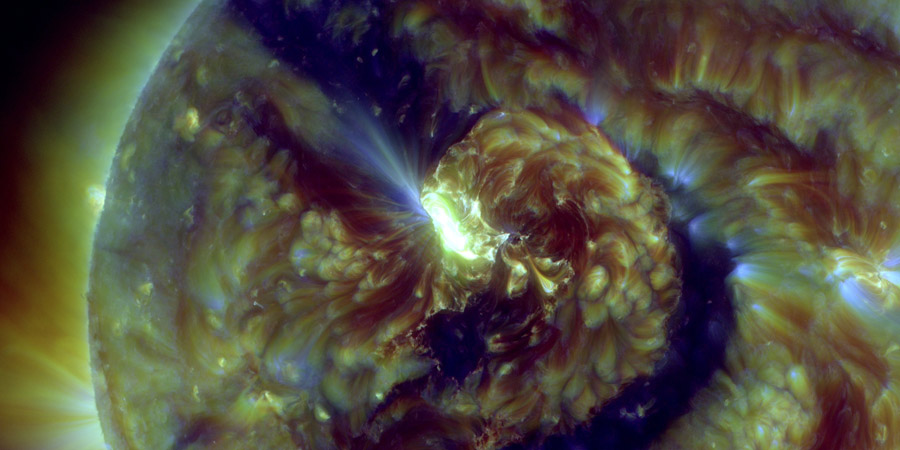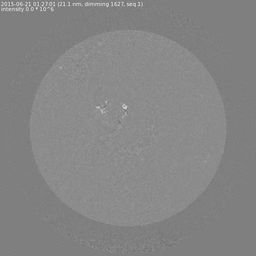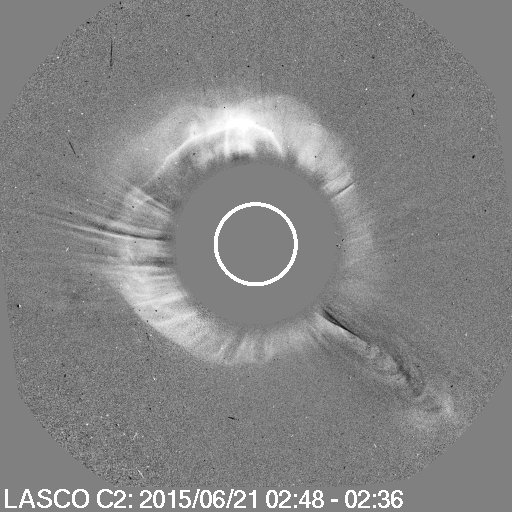M2.0 and M2.6 solar flares with full halo CME
Sunday, 21 June 2015 06:50 UTC

A double peaked long duration solar flare (M2.0 and M2.6) took place around sunspot region 2371 early this morning between 01:42 UTC and 02:35 UTC. The beginning of a symmetrical (!) full halo coronal mass ejection is becoming visible on SOHO coronagraph imagery meaning an impact at Earth can be expected in a few days.
Video: the M2.0/M2.6 solar flares as seen by SDO in the 193 Angstrom wavelength.

Animation: SDO/AIA 211A difference animation from the SIDC showing significant coronal dimming follow the flares.
While this solar flare was again not very strong when you consider the raw power that X-class solar flares bring to the table, this event was again eruptive and SDO difference imagery showed some significant coronal dimming following the flare. What this tells us is that a coronal mass ejection was to be expected.
A quick look at the most recent SOHO/LASCO imagery is confirming our suspicion and the beginning of a symmetrical (!) full halo coronal mass ejection is now visible. An earth-directed component is pretty much certain. Possible impact time and expected geomagnetic effects will be determined later when more imagery becomes available. Keep an eye on the website for a thorough analysis when more imagery becomes available.

Image: SOHO/LASCO difference image by NASA showing the the beginning of a symmetrical (!) full halo coronal mass ejection.
NOAA SWPC alerts
ALERT: Type IV Radio Emission Begin Time: 2015 Jun 21 0224 UTC
ALERT: Type II Radio Emission Begin Time: 2015 Jun 21 0224 UTC Estimated Velocity: 682 km/s
SUMMARY: 10cm Radio Burst Begin Time: 2015 Jun 21 0207 UTC Maximum Time: 2015 Jun 21 0226 UTC End Time: 2015 Jun 21 0314 UTC Duration: 67 minutes Peak Flux: 409 sfu Latest Penticton Noon Flux: 135 sfu
Thank you for reading this article! Did you have any trouble with the technical terms used in this article? Our help section is the place to be where you can find in-depth articles, a FAQ and a list with common abbreviations. Still puzzled? Just post on our forum where we will help you the best we can!
Latest news
Latest forum messages
Support SpaceWeatherLive.com!
A lot of people come to SpaceWeatherLive to follow the Sun's activity or if there is aurora to be seen, but with more traffic comes higher server costs. Consider a donation if you enjoy SpaceWeatherLive so we can keep the website online!

Space weather facts
| Last X-flare | 2025/03/28 | X1.1 |
| Last M-flare | 2025/04/30 | M2.03 |
| Last geomagnetic storm | 2025/04/21 | Kp5+ (G1) |
| Spotless days | |
|---|---|
| Last spotless day | 2022/06/08 |
| Monthly mean Sunspot Number | |
|---|---|
| March 2025 | 134.2 -20.4 |
| Last 30 days | 123.3 -5.8 |


